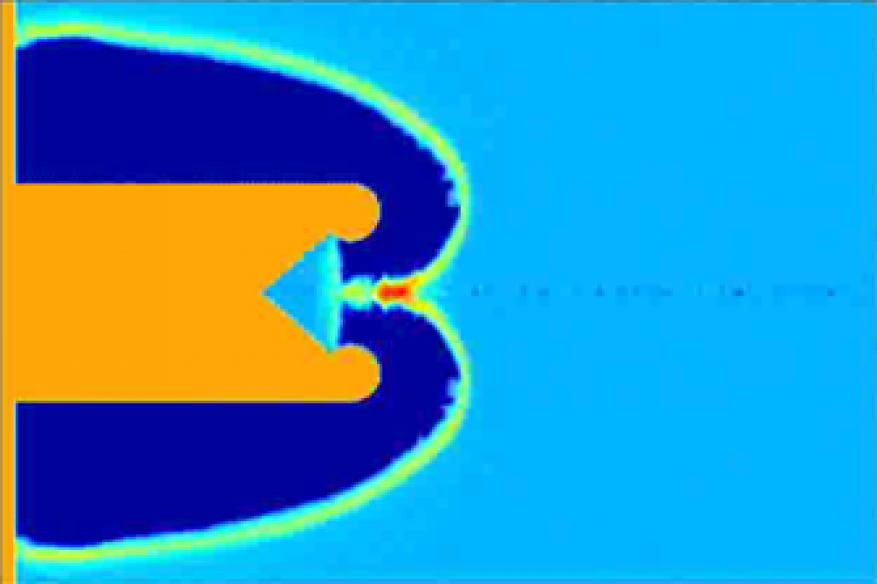Andrea Schmidt (15-ERD-034)
Abstract
Compact high-flux, reusable neutron sources that operate in deuterium fuel are of interest to a variety of fundamental research areas in radiation detection, nuclear physics, astrophysical processes, and Inertial Confinement Fusion. Miniature dense-plasma focus Z-pinch devices could fill this need if their yield was increased and their pulse is lengthened. The name refers to the direction of the current in these devices, the Z-axis on a normal three-dimensional graph. The device is a plasma-confinement system consisting of two coaxially located electrodes with a high-voltage source at one end. In the presence of a low-pressure gas, the high-voltage source induces a plasma sheath formation. The plasma sheath is pushed down the length of the electrode, collapses, and implodes, creating a high-density pinch effect that emits high-energy electron and ion beams, x rays, and neutrons in the presence of deuterium. In this project, we are using a unique LLNL simulation tool to better understand the kinetic instabilities in these plasmas that drive the ion beam formation and neutron yield. Through simulations, we will gain an understanding of how different driver properties affect the formation of these instabilities, and will perform the first three-dimensional kinetic dense-plasma focus calculations. We will apply this new understanding to increase yield in a miniature dense-plasma focus device with stockpile stewardship applications in mind.
If this project is successful, we will pursue building a prototype compact dense-plasma focus device using static-gas-fill deuterium that achieves relevant yields for stockpile stewardship applications. Such a compact, short-pulse neutron source could also have relevance for portable active interrogation relevant to nonproliferation and nuclear terrorism. We are leveraging the modeling capabilities developed at Lawrence Livermore to identify parameters for the kinetic instabilities that create large-beam-forming gradients, a fundamental science problem that remains unsolved after 40 years of Z-pinch research. An understanding of these instabilities and the conditions under which they arise would allow us to control and tailor the behavior of dense-plasma focus systems, enabling key applications. We expect to characterize and optimize the neutron pulse shape to lengthen the neutron pulse with our proposed device. The approach will be to purposefully induce multiple pinches. Additionally, the presence of a solid target will lengthen each pinch's neutron pulse by about 70 ns because of time-of-flight considerations for a target that is 5 cm from the pinch. We will use a scintillator in current mode for this measurement. In addition, we will introduce the first three-dimensional fully kinetic modeling of a dense-plasma focus system.
Mission Relevance
This project enhances capabilities in fully kinetic Z-pinch modeling, a component of the Laboratory's high-energy-density science core competency. Our work also enables applications in the strategic focus area of stockpile stewardship science in which the predictive capability for nuclear weapon performance requires fundamental understanding of extreme, high-energy-density states of matter. In addition, creating a path to portable neutron sources to be used for active radiation interrogation would enable key applications for nuclear threat reduction, and is relevant to the core competency in nuclear, chemical, and isotopic science and technology.FY15 Accomplishments and Results
In FY15 we (1) modeled two different miniature dense-plasma focus devices from the literature, and found that our predicted yield matched the yield reported, although one of the two devices performed at a much higher level; (2) initiated simulations, beginning with the higher-performing device to optimize that design; (3) scanned anode shape, pressure, and length; (4) developed a design for the new device (the electrodes, back-end driver, and transmission system); and (5) completed a design review.Publications and Presentations
- Schmidt, A., et al., Kinetic simulations of dense plasma focus breakdown. 57th Ann. Mtg. APS Division of Plasma Physics, Savannah, GA, Nov. 16–20, 2015. LLNL-ABS-675188.
- Sears, J., et al., The role of the driver circuit in chaotic processes and the neutron yield of the plasma focus. 57th Ann. Mtg. APS Division of Plasma Physics, Savannah, GA, Nov. 16–20, 2015. LLNL-ABS-670450.






